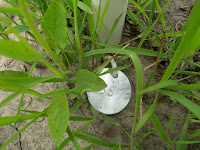 After a long week that which was lost is found, and lessons are learned. Let’s be honest, it just doesn’t sound professional to admit you can’t find your study plots even if events outside of your control rendered them nearly invisible in a tangled mass of prairie vegetation. This picture shows how easy the tags are to find when they have a big PVC pipe standing next to them after a burn. Now take away the PVC, let the vegetation grow for 40 days, then put it all under a bale of hay. Not so easy is it?
After a long week that which was lost is found, and lessons are learned. Let’s be honest, it just doesn’t sound professional to admit you can’t find your study plots even if events outside of your control rendered them nearly invisible in a tangled mass of prairie vegetation. This picture shows how easy the tags are to find when they have a big PVC pipe standing next to them after a burn. Now take away the PVC, let the vegetation grow for 40 days, then put it all under a bale of hay. Not so easy is it? With a big investment in time, an average of 6 minutes per plot, all 108 plots have been found via a combination of luck, precision, persistence, and technology. And all of your outpouring of concern in the comments of my previous field research blog touched me greatly. But the field has a way of teaching you lessons about life. Nature isn’t there to do your bidding. Nature never cooperates, and if anything can go wrong, it will, so be prepared. All field researchers know these things, but if you actually told students the truth they never would elect to do field research. And then somebody questions you marginally significant data. The git! With all the noise out there, any reaction to your treatments at all is significant! The biggest lesson is that our best efforts to map plot locations are barely adequate and sometimes a bit of wandering in a favorable vicinity (Wasn't there a plot just about here?) and luck, aided by acute observations, provided a starting point to serve as an initial frame of reference. Even when you found a corner of a one meter square plot, it could be difficult to find the SW corner’s spike that actually provides the fixed reference point. So finding the next plot some 10 to 60 meters away remains quite a challenge. That’s the trouble with prairies, no obvious land marks. One the plus side, another lesson is that linear distances recorded in prior years were quite accurate, far more so than compass bearings, so if we had distances from two “found” plots to a missing plot it could be located sometimes to within an inch, or 8. Don’t know what that says about the Phactor’s low tech skill set, but if you want to know the distance from A to B, Robotape is a great device, sort of a laser tag with precision. How some things happen remains a mystery. Some plot tags had dug themselves in, buried beneath the soil, and without a metal detector they never would have been found, fire or not. And who knew so much lose change would be laying around a prairie just waiting to be found? Not! But the beeping kept us alert. Some plot tags had "crawled away", which made the corner spike even harder to find, but at least the spikes never wandered. Now on to the treatments which had to wait until the plots were found, and of all of these eradication is the worst.
















No comments:
Post a Comment